When you hear the word “pollinator,” you usually think of
the honey bee. That’s because the honey
bee, Apis mellifera, is an outstanding
pollinator. As industrious and social
creatures, honey bees devote much of their time to efficiently collecting large
quantities of pollen to feed the hive’s offspring, pollinating many flowers in
the process. However, some less obvious
insects sip nectar in the garden, and while less efficient than honey bees or
native bees, should be recognized as valuable pollinators. Although often overlooked, a variety of
moths, wasps, and flies pollinate flowers.
MOTHS
Although
the majority of moths are active at night, some nectar-drinking moths are
diurnal, or daytime feeders. One
particular moth is busy in the garden all summer long. The hummingbird moth, Hemaris diffinis, mimics a hummingbird in appearance and
movement. Its long proboscis, or tongue,
makes it a good pollinator for tubular shaped flowers. It can be seen nectaring on verbena, bee
balm, petunias, and a variety of flowers.
The
small yellow-collared scape moth, Cisseps
fulvicollis, hardly looks like a moth.
It is another daytime forager found on a variety of flowers throughout
summer. It is active during the day as
well as around dusk.
The colorful
ailanthus webworm moth, Atteva aurea,
is a member of the bagworm family. In
addition to pollinating flowers, this moth lays its eggs on the invasive
ailanthus tree, and the caterpillars eat the leaves. The tree is also known as the “tree of
heaven,” an invasive species from China that is crowding out our native trees
in many areas of Virginia.
WASPS
Wasps
make good pollinators. In fact, bees are
descended from wasps and share many similar characteristics. The common thread-waisted wasp, Ammophilia procera, drinks nectar as an
adult, visiting and pollinating flowers along the way. It also performs other garden duties, such as
insect control, by feeding insects to its young. It is not aggressive to humans but will sting
if provoked. Only the females can sting,
and can sting repeatedly without losing its stinger.
Another pollinating wasp, the blue-winged Scolia dubia, is an asset to have in the
garden. These solitary wasps lay their
eggs underground on the larvae of green June beetles and other lawn pests. Adults, busy sipping nectar throughout the
garden and providing for their young, are not a threat to people if left alone.
FLIES
Not all
flies are houseflies. Many flies are
important pollinators. For example, some foul-smelling flowers depend on flies
for pollination. Other flies are simply
mistaken for bees. Flower flies, Syrphidae, mimic bees, wasps and yellow
jackets in appearance, but are actually harmless. Many are beneficial because their larvae eat
aphids and other garden pests.
Tachinid flies, Tachinidae,
covered with hairy spikes, can also be found sipping nectar. In addition to pollinating flowers, they
produce larvae that consume the larvae of other insects.
While bees continue to be perhaps our most valuable
pollinators, many secondary pollinators shouldn’t be overlooked. With so many flowers that require pollination
in a limited season of time, it takes a variety of pollinators to get the job
done. As gardeners, it is important for
us to recognize the benefits of having a variety of insects in our garden by
providing a variety of nectar sources and limiting pesticide use.













































